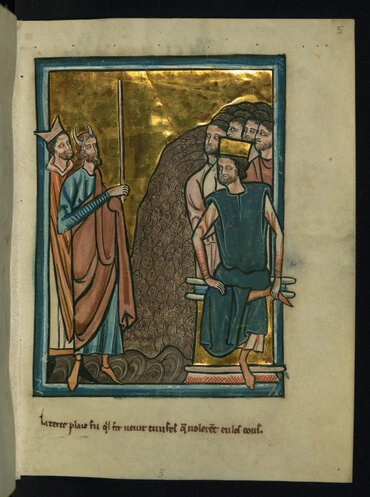Aaron

Aaron was the brother of Moses. He symbolizes two things, at different stages of the story.
During the first part of the exodus, when he was Moses' spokesperson, Moses represents the Word as it truly is, as it is understood in heaven, while Aaron represents the Word in its external sense, as it is understood by people in the world. This is why Aaron talks for Moses, and the Lord says of him "he shall be as a mouth for you, and you shall be to him as God." (Exodus 4:16)
Later, after the Tabernacle was built and he was inaugurated as high priest (see Leviticus 8,9), Aaron represents the Lord as to the Divine Good, and Moses represents the Lord as to the Divine Truth.
In Exodus 28:1, Aaron signifies the conjunction of Divine Good with Divine Truth in the Divine Human of the Lord. (Arcana Coelestia 9806, 9936)
In Exodus 32:1, Aaron represents the external of the Word, of the church, and of worship, separate from the internal. (Arcana Coelestia 10397)
In Exodus 4:14, before he was initiated into the priesthood, Aaron represents the doctrine of good and truth. (Arcana Coelestia 6998)
Arcana Coelestia # 5328
5328. 'Or his foot' means all power in the natural. This is clear from the meaning of 'foot' as the natural, dealt with in 2162, 3147, 3761, 3986, 4280, 4931-4952. Here power within the natural is meant because 'lifting up the foot', like 'lifting up the hand', means power, though 'lifting up the hand' means power in the spiritual, whereas 'lifting up the foot' means power in the natural; for the parts within the body that are above the feet correspond to spiritual things. This is especially evident from the Grand Man or the three heavens.
[2] Whenever the whole of heaven is displayed visually as one human being, the inmost or third heaven presents itself as the head, the middle or second heaven presents itself as the body, and the lowest or first as the feet. The reason the inmost or third heaven presents itself as the head is that it is celestial; the reason the middle or second heaven presents itself as the body is that it is spiritual; and the reason the lowest or first presents itself as the feet is that it is natural. By 'the neck' therefore, since this is an intermediate part, is meant the inflow and communication of celestial things with spiritual ones; and by 'the knees', since these are likewise intermediate, is meant the inflow and communication of spiritual things with natural ones. From this it is evident that 'lifting up the hand' means power within the spiritual, while 'lifting up the foot' means power within the natural, and therefore that the power meant by 'the hand' has regard to the spiritual, namely to truth grounded in good, 3091, 3567, 4932. By the spiritual is meant that within the natural which belongs to the light of heaven, and by the natural that within the natural which belongs to the light of the world; for everything belonging to the light of heaven is called spiritual, and everything belonging to the light of the world is called natural.






